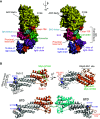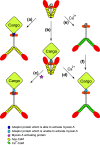Regulation of class V myosin
- PMID: 28730277
- PMCID: PMC11105390
- DOI: 10.1007/s00018-017-2599-5
Regulation of class V myosin
Abstract
Class V myosin (myosin-5) is a molecular motor that functions as an organelle transporter. The activation of myosin-5's motor function has long been known to be associated with a transition from the folded conformation in the off-state to the extended conformation in the on-state, but only recently have we begun to understand the underlying mechanism. The globular tail domain (GTD) of myosin-5 has been identified as the inhibitory domain and has recently been shown to function as a dimer in regulating the motor function. The folded off-state of myosin-5 is stabilized by multiple intramolecular interactions, including head-GTD interactions, GTD-GTD interactions, and interactions between the GTD and the C-terminus of the first coiled-coil segment. Any cellular factor that affects these intramolecular interactions and thus the stability of the folded conformation of myosin-5 would be expected to regulate myosin-5 motor function. Both the adaptor proteins of myosin-5 and Ca2+ are potential regulators of myosin-5 motor function, because they can destabilize its folded conformation. A combination of these regulators provides a versatile scheme in regulating myosin-5 motor function in the cell.
Keywords: Actin; Allosteric regulation; Calmodulin; Molecular motor; Myosin-5.
Conflict of interest statement
The authors declare that they have no conflicts of interest with the contents of this article.
Figures




References
Publication types
MeSH terms
Substances
Grants and funding
LinkOut - more resources
Full Text Sources
Other Literature Sources
Miscellaneous

